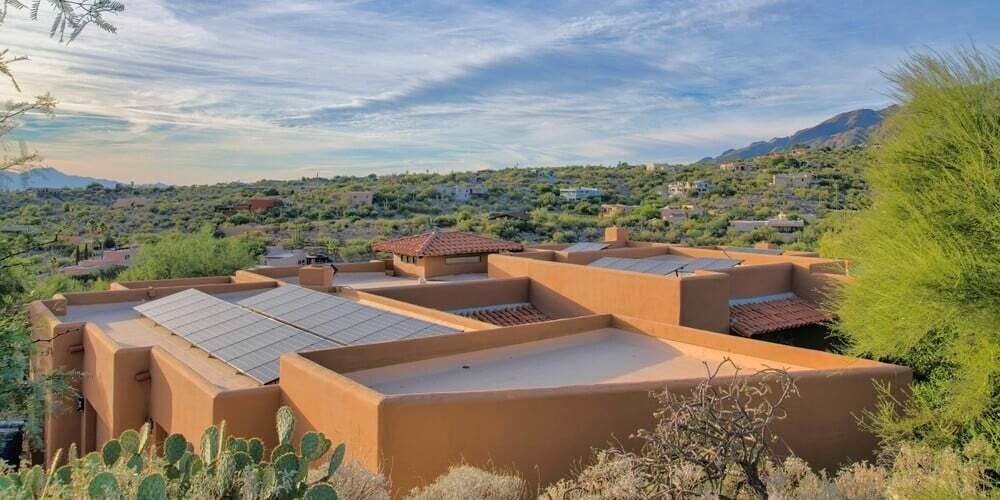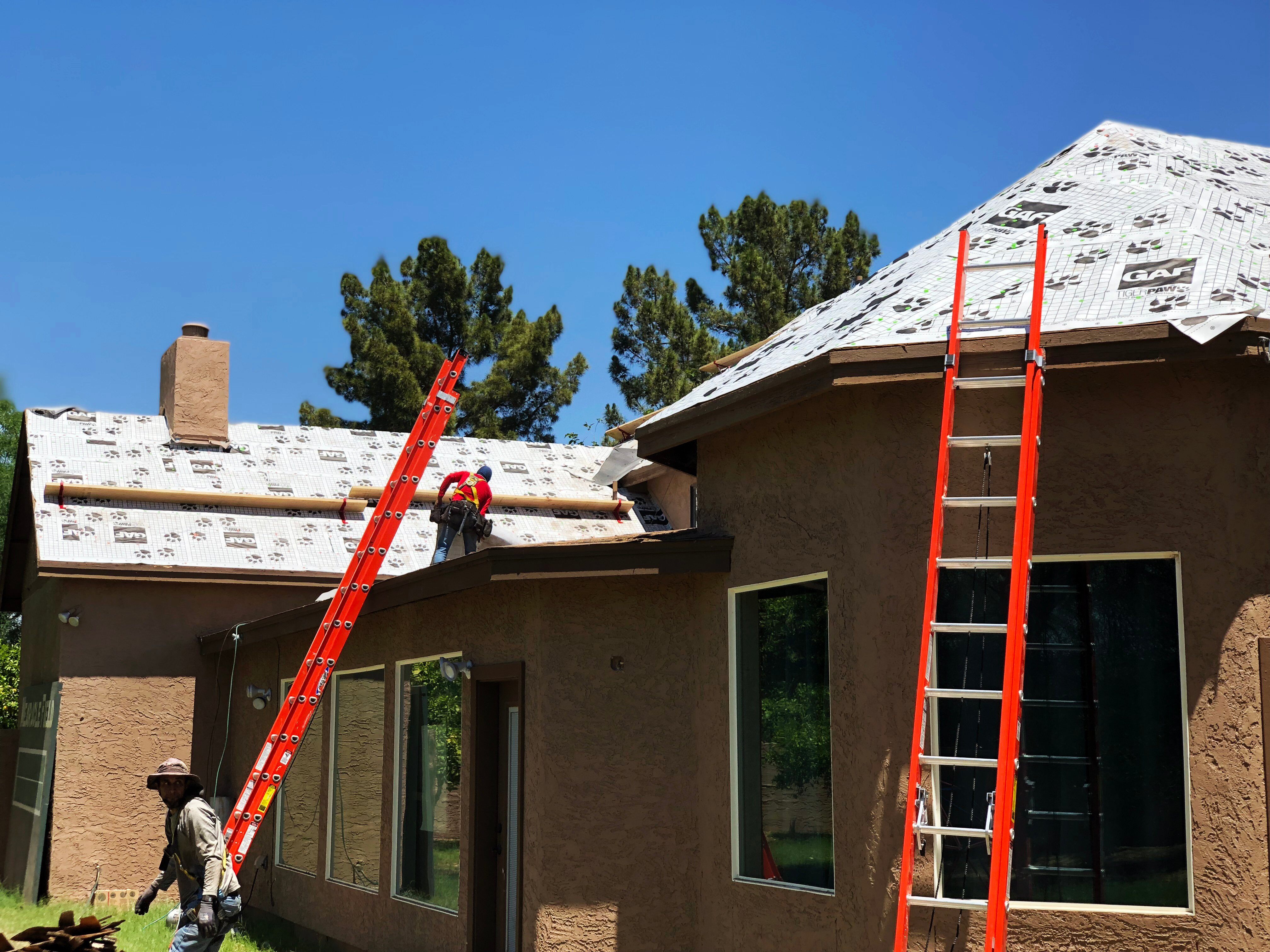Roof Underlayment 101: What It Is & Why It’s Important
Home / Azul Blog / Roof Underlayment 101: What It Is & Why It’s Important When most homeowners think about their roof, they picture the tiles, shingles, or foam that cover the top...
7 min read
Paul Hammons, Production Manager : October 16, 2025

Flat roofs are a popular choice in Arizona, especially in Scottsdale, Mesa, and the surrounding desert communities that make up the greater Phoenix metro. Their clean lines, energy efficiency, durability, and space-saving design make them perfect for Southwest architecture. But Arizona’s intense sun, seasonal monsoons, and wide temperature swings create tough conditions that can quickly shorten a roof’s lifespan if not properly maintained.
Whether the flat roof on your home or business is composed of foam, modified bitumen, or elastomeric, these easy maintenance tips will help you extend its life, prevent leaks, and protect your property from costly damage.
Arizona buildings commonly use a few key flat-roof systems, each with unique maintenance needs:
Knowing your roof material helps you choose the right cleaning methods, repair products and general maintenance procedures. Not all coatings or sealants are compatible, so always check with a licensed Arizona roofer before applying anything new to your roof.
Read more: Pros & Cons of Flat Roofs in Arizona
Arizona’s long dry spells can make roof leaks hard to detect, even though water damage is just as destructive here as anywhere else. A single strong storm can expose a hidden issue that’s been building for months. That’s why it’s important to schedule a roof inspection after our rainy—and often violent—monsoon season. Don’t let a small breach go unnoticed until next year’s storms.
During each inspection:
Document what you find with photos. Over time, you’ll spot patterns of wear that help you plan proactive maintenance.
Arizona’s desert winds carry sand and debris that accumulate on flat roofs. Additionally, Pigeons love to roost and build nests on Arizona roofs of all types. All this leads to buildup that traps heat, clogs drains, and holds moisture after rain.
A clean roof surface not only looks better but also reflects more sunlight and ensures proper water shedding. Equally as important, a healthy, clean roof keeps your home cooler and your electric bills lower.
Standing water (“ponding”) is a major threat to flat roofs in the desert. It usually indicates a blocked drain, uneven slope, or compressed insulation beneath the surface. As water sits and bakes in the sun, it can prematurely degrade the materials.
Many foam roofs are installed with a built-in slope to promote runoff — but shifting building movement or heavy rain can still cause low spots to form. If pooling is an issue, we strongly recommend a professional inspection to ensure that repairs are done correctly and with like materials.
The Valley’s relentless sun is brutal on roofing materials. UV radiation dries out sealants, breaks down coatings, and fades reflective surfaces over time.
A bright white or light-gray coating can reduce roof surface temperatures by 50°F or more, saving energy and extending the life of your foam or membrane.
The most common leak points on Arizona flat roofs are around flashings, vents, and skylights. Any penetration points, including electrical connections or solar panel racking systems can also be problematic if not properly installed and maintained.
Have your roofer reseal with high-quality, UV-resistant roofing sealant designed for your specific roof type. Avoid generic silicone or asphalt sealants unless verified to be compatible with your existing coating.
Foam and coated flat roofs need periodic recoating to preserve their waterproof seal and UV protection. While conditions vary by roof and climate, a good rule of thumb is:
If the topcoat wears away, UV rays can degrade the foam underneath — leading to costly re-foaming instead of a simple recoat. This is why maintenance and regular inspections are key.
Professional Arizona roofers can measure coating thickness, test adhesion, and reapply elastomeric or silicone coatings that work well with your roofing material and meet current energy standards.
Read more: Common FAQs: A Guide to Arizona Flat Roofs
A minor crack or blister today can become a leak during the next monsoon storm.
Don’t wait — small proactive repairs can save you many thousands of dollars later.
Azul Roofing Solutions and other local experts have infrared moisture-detection tools to pinpoint leaks before they become serious. What’s more, We offer free, no-obligation roofing inspections, so don’t delay if you think a repair is needed
Many Arizona homes have HVAC units, solar panels, or satellite dishes mounted directly on flat roofs. These penetrations create additional stress points.
If you suspect a leak and have solar panels, it’s often best to coordinate inspection schedules so your roofer and solar provider can check seals together. Azul Roofing frequently partners with our sister company, Sun Valley Solar Solutions, to simplify the process for homeowners. This collaboration provides a single point of contact for scheduling, repairs, and even panel removal and reinstallation when roof work is needed beneath the solar array.
Flat roofs in Arizona can easily last 20–30 years — but only with consistent care. Partnering with a trusted, licensed roofing contractor ensures you catch issues early.
For commercial buildings, some insurers and warranty providers require documented maintenance from a licensed Arizona roofing company like Azul Roofing Solutions.
Tracking your roof’s condition is invaluable for resale, warranty claims, and planning future repairs. Buyers appreciate documentation that shows a home was well-maintained and professionally repaired, and that recordkeeping can often help you command a higher selling price.
This simple record can save headaches later and demonstrates responsible ownership — especially valuable when selling your home or renewing insurance.
Arizona’s desert climate brings unique challenges that require smart timing:
|
Season |
Maintenance Focus |
|
Spring (Mar–May) |
Clean debris, inspect foam or coating, reseal flashings before monsoon. |
|
Monsoon (Jun–Sep) |
Monitor roof after storms for leaks or ponding. |
|
Fall (Oct–Nov) |
Schedule professional inspection or recoating. |
|
Winter (Dec–Feb) |
Minimal rainfall, ideal for coating projects or foam repairs. |
By syncing your maintenance schedule with Arizona’s weather patterns, you’ll maximize results and minimize downtime.
Regular flat roof maintenance is one of the smartest investments Arizona homeowners can make. With a little attention after each monsoon season—and the help of trusted local experts like Azul Roofing Solutions—you can keep your roof watertight, energy-efficient, and ready to handle the desert’s toughest conditions.
Contact Azul Roofing Solutions for a free, no-pressure roof inspection. Our Phoenix-based team specializes in foam and flat-roof maintenance, recoating, and repair, keeping Arizona roofs strong, cool, and watertight year-round.
Schedule your roof inspection today and keep your home protected for years to come.
Twice a year — once before monsoon season (spring) and once after (fall). Arizona’s extreme UV and sudden storms make these inspections essential.
With proper recoating and maintenance, a foam roof can last 25–30 years or more. Neglecting recoating can cut that lifespan significantly.
Silicone and high-reflectivity elastomeric coatings perform best in desert climates. They reflect sunlight, resist UV degradation, and stay flexible in heat.
Look for dull color, chalking, cracks, or exposed yellow foam. If water no longer beads up on the surface after rain, it’s time to recoat.
Yes, but carefully. Use soft-soled shoes and avoid stepping on blistered or soft spots. Frequent foot traffic should be limited to walk pads.
Persistent water pooling accelerates coating failure, encourages algae growth, and can eventually lead to roof leaks or structural damage.
Absolutely. Arizona’s climate is unique. Local roofers understand the materials, codes, and timing needed for foam and flat-roof systems here in the Valley.

Home / Azul Blog / Roof Underlayment 101: What It Is & Why It’s Important When most homeowners think about their roof, they picture the tiles, shingles, or foam that cover the top...